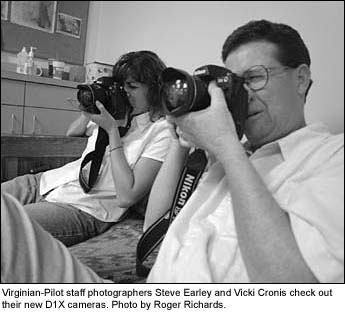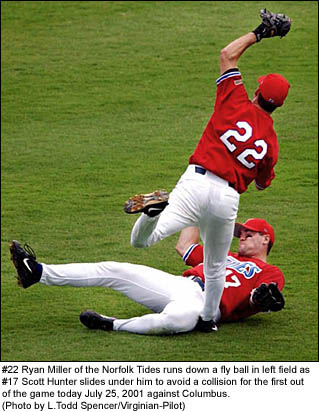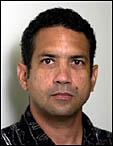 The
coming of the Digital Age has meant that digital image capture and
transmission is fast becoming the industry standard because of speed
and reduced cost to publications. For those photojournalists who have
stuck to their film emulsions because of its superior image quality
and archival properties, and have been recoiling in horror as the
digital tide has steadily crept up on them, relief of sorts is now
here. It is called the Nikon
D1x, and it is capable of producing images very near to the resolution
of film.
The
coming of the Digital Age has meant that digital image capture and
transmission is fast becoming the industry standard because of speed
and reduced cost to publications. For those photojournalists who have
stuck to their film emulsions because of its superior image quality
and archival properties, and have been recoiling in horror as the
digital tide has steadily crept up on them, relief of sorts is now
here. It is called the Nikon
D1x, and it is capable of producing images very near to the resolution
of film.
My switch from shooting film to mostly digital began when I left my
staff job at The Washington Times in Washington, DC, and joined
The Virginian-Pilot in Norfolk, VA. In Washington I used both
the old Nikon-Kodak NC2000E and 1st generation Nikon D-1, mostly for
sports, late deadline events or for transmitting from the road. I
liked the D-1 but did not envision giving up shooting film for a while
as digital image quality was still not even close.
 When
I got to the Pilot, director of photography Alex Burrows said that
his goal was to outfit the entire staff with new digital gear as soon
as the new Nikon D1x was released. Most photojournalists on the staff
had one D-1 but still shot mostly film. Two people only were exclusively
digital. Since that conversation a few months ago, the Pilot has issued
two Nikon digital cameras (one D1x, one D1), Apple G4 laptops and
cell phones for remote transmission to all staff photographers.
When
I got to the Pilot, director of photography Alex Burrows said that
his goal was to outfit the entire staff with new digital gear as soon
as the new Nikon D1x was released. Most photojournalists on the staff
had one D-1 but still shot mostly film. Two people only were exclusively
digital. Since that conversation a few months ago, the Pilot has issued
two Nikon digital cameras (one D1x, one D1), Apple G4 laptops and
cell phones for remote transmission to all staff photographers.
I wish to note at this time that the following general observations
are aimed at those with some familiarity with the Nikon D1. For more
technical specifications about the D1x, go to http://www.robgalbraith.com
or visit
Nikon's website.
The Nikon D1x has a 5.47 megapixel CCD that allows capture of images
up to 3,008x1960 pixels. Like the film camera on which it is based,
the Nikon F100, the D1x/D1 fits perfectly in my hand. It is solidly
built of metal with rubber coating on the grips that helps the tangible
'feel' of the camera. The controls are easy to find and use. I must
say that as a past user of Canon SLR's this is the best series of
cameras Nikon has made that come close to the excellent ergonomic
design of the Canon EOS-1 cameras.
For daily use here at the Virginian-Pilot, we have set the camera
to capture at JPEG NORMAL quality (compressed at about 1:8), and end
up with a 16.9 megabyte image file. By comparison, the previous D1
camera has a 2.47 megapixel CCD and with the capture setting on JPEG
FINE, the normal image file size is about 7.9 megabytes. That is more
than double what we were getting with a D1. It now also means that
if, for instance, we need to obtain a tight head shot from a wideangle
photo the quality is not as adversely affected as before. The difference
is remarkable, in my estimation. Our image database system at the
Pilot is set up to store 8 megabyte files. With a 17MB original we
have to decrease to an 8MB file.
The ISO film speed range of the D1x is 125 to 800, and can be adjusted
in 1/3, 1/2 or 1 stop increments by selecting custom function #20.
At ISO 125, the photographs almost look as if they were shot on slide
film. The first frames I shot with the camera were on a sunny afternoon
and I was surprised at the color saturation, bright reds with deep
blues. I realized that I would have to handle the D1x differently
from the way that I had been used to shooting with the D1 as the new
camera is a completely different unit in many aspects. For example,
I use the automatic camera functions a lot, particularly the aperture
priority mode. On the D1, I usually dial in -.7 to -1 stop underexposure
in the exposure compensation control, using evaluative metering (the
exceptions are when I am shooting sports or controlled lighting situations,
when I switch to manual mode). On the D1x this resulted in a deeply
underexposed image. The D1 is biased in the opposite direction toward
being neutral/overexposed. The D1x works best when the exposure is
handled as if you are shooting slow speed transparency film. At ISO
800, there is much less noise in the image than the D1. When needed,
the D1x's ISO sensitivity can be increased by selecting the ISO BOOST
custom function (#31) and can be raised by the equivalent of 2 stops.
 While
the improvement in image quality, expanded ISO range and larger file
size is great, one big drawback I found with the D1x is that it is
not really suitable for shooting sports or fast action because of
the slow motor drive/image buffering. Fellow Virginian-pilot staffer
L. Todd Spencer, one of the paper's sports specialists, says "They
have to put the speed back in the camera. The large file size is nice
for cropping for sports. We thought the D1 was slow, but the D1x is
ungodly slow compared to the Nikon F5's that we were using as our
main sports camera. But you can't process your film on the sidelines."
While
the improvement in image quality, expanded ISO range and larger file
size is great, one big drawback I found with the D1x is that it is
not really suitable for shooting sports or fast action because of
the slow motor drive/image buffering. Fellow Virginian-pilot staffer
L. Todd Spencer, one of the paper's sports specialists, says "They
have to put the speed back in the camera. The large file size is nice
for cropping for sports. We thought the D1 was slow, but the D1x is
ungodly slow compared to the Nikon F5's that we were using as our
main sports camera. But you can't process your film on the sidelines."
One of the really nice improvements on the D1x is the fact that the
rear LCD monitor screen will allow you to see the full frame of a
captured photo. The screen on the D1 vignettes around the edges, so
you were never really sure what you had, which can be a pain when
working on deadline. The new monitor also offers a slightly darker
photo compared to the one on the D1, meaning that a normally exposed
image looks about 1 stop underexposed on the screen. The neatest part
of the improved monitor screen on the D1x is that when you bring up
an image it is possible to select an area of the photo, for instance
a face, and zoom in to see if it is in focus or to make an identification
of a person. Nikon is also shipping the D1x with a transparent cover
over the screen, better than the one that came with the previous D1.
That black cover necessitated removal to view the screen. That said,
I found the new Nikon clear screen to not be as good as the aftermarket
Hoodman LCD cap, two of these are on the backs of my cameras.
The D1x works really well with the Nikon SB28-DX dedicated flash.
Using this flash on a D1 was a big challenge. Now it is easy to control,
and using it as a fill-in light is very simple. I usually dial down
about -1 stop on the SB28-DX when working close to a subject. Going
down -3 stops, necessary when using the D1 to make photos that are
not blown-out, means very subtle shadow fill when used direct on the
D1x.
Overall, I am very pleased with the latest effort from Nikon. It will
only be a matter of time before the quality of digital images equal
and even surpass the quality of film emulsions. The main drawback,
that of the archiving of images for future use, is one that I have
thought of a lot since making the switch to shooting digitally almost
exclusively. My personal solution (for now) will be to make high quality
ink jet prints on archival paper of my favorite images and store them
in archival boxes. There is no going back to the old ways. As individual
photojournalists, until this archiving dilemma is resolved, the best
we can do is try to come up with ways to preserve the images close
to our hearts.
Roger Richards
Contributing Editor
Publisher, The Digital Filmmaker
rrichard@pilotonline.com

